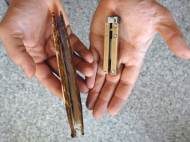Biomimicry of clams for more efficient anchors
 Another great example of bio-mimetic robots is a solution many mariners, oil outfits, and the military have big hopes for. RoboClam, designed at the MIT, is meant to become the first “smart” anchor, a major departure from the prosaic piece of nautical gear that hasn’t changed much in centuries. Its present diminutive size is just for test purposes; eventually, its engineers predict, the artificial bivalve will be built to scales suitable for securing deepwater craft.
Another great example of bio-mimetic robots is a solution many mariners, oil outfits, and the military have big hopes for. RoboClam, designed at the MIT, is meant to become the first “smart” anchor, a major departure from the prosaic piece of nautical gear that hasn’t changed much in centuries. Its present diminutive size is just for test purposes; eventually, its engineers predict, the artificial bivalve will be built to scales suitable for securing deepwater craft.
In appearance, the RoboClam prototype is a modest rectangle of hinged bronze and steel, about the size of a deck of playing cards. In function, however, the device mimics the considerable burrowing skills of a razor clam – a common mollusk with an uncommon twitchy style of locomotion that MIT researchers have replicated in the RoboClam design.
“We want to make an anchor that can dig itself down to the right position to hold the vessel securely – and then, just as critically, easily reposition or free itself,” said Anette Hosoi, the professor of mechanical engineering overseeing development of the robot.
“We started two years ago looking at all creatures that burrow into undersea strata,” said Amos G. Winter, a graduate student who has performed much of the work making RoboClam reality. “Quahogs, crabs, seaworms . . . .”
Armed with a shellfish license and homemade clam rake, and bundled into a cumbersome pair of chest waders, Winter scoured tidal flats near Gloucester, studying the creatures that thrive in the fecund sand and mud. Razor clams grabbed his attention – for their speed, sleek shape, and stubborn tenacity in holding fast when finally cornered in the muck. On a measure of anchoring force, Winter said, “razor clams beat everything, including the best anchors, by a factor of 10.”
The creature can move through hard-packed sand, or thick sediment, at a “blistering” speed 1cm per second, he said, making the razor clam “the Ferrari of bivalves.”
But the speed of the clams posed a mystery. In lab tests, the MIT researchers were puzzled to find that real-life clams were burrowing at velocities that seemed physiologically impossible, seemingly requiring far more force to push through the sand than the animals could exert.
The clam first wiggles a fleshy foot into the sand below and pushes its shelled body upward. This creates a tiny pocket of space under the shell, which sucks in both water and sand. At the same time, it clamps shut its shell with a pronounced twitch that creates more slick slurry, while pumping blood into the extended foot.
For now, RoboClam remains in the experimental stage, powered by compressed air and reliant on external piston drives for its twitches. The next step is a model that can operate on its own in real world conditions. Some of the tasks RoboClam could perform include anchoring small robotic surveillance vehicles, anchoring equipment designed to monitor changing water currents or other similar variables, and detonating buried underwater mines.










Leave your response!